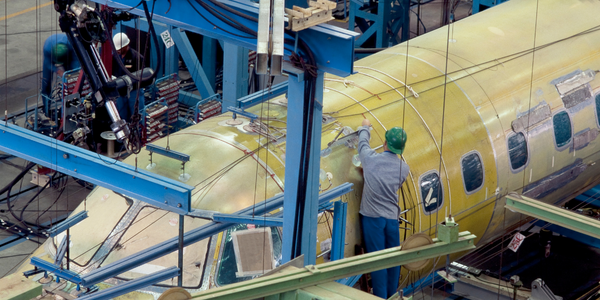
技术
- 功能应用 - 计算机化维护管理系统 (CMMS)
- 传感器 - 全球定位系统
适用行业
- 航天
适用功能
- 维护
客户
Avemex
关于客户
Avemex总部位于墨西哥托卢卡,提供全方位的公务航空服务,包括飞机管理和包机服务。该公司的维护、修理和大修 (MRO) 中心支持公务机和涡轮螺旋桨飞机,包括所有类型的 Cessna Citation、Beechcraft King Airs、Pilatus PC-12 和 Honda Jets。
挑战
Avemex 服务中心是联邦航空局 (FAA) 维修站和民用航空总局 (DGAC) 维修车间。它提供地面飞机 (AOG) 技术支持、主要结构维修和改造、改装和升级 (RMU)。 30 多年来,Avemex 一直是霍尼韦尔的合作伙伴。
今天,该公司是一家优质经销商,支持霍尼韦尔的所有航空电子解决方案。霍尼韦尔为他们提供及时的支持,为客户提供最佳和最有效的解决方案。
解决方案
ADS-B Out 使飞机能够使用精确的 GPS 数据实时准确定位其位置,并将这些数据连同其识别、高度和速度一起广播给周围的飞机和空中交通管制 (ATC)。该信息每秒广播一次,可以作为二次雷达的补充,由 ATC 地面站接收。
运营影响
数量效益

Case Study missing?
Start adding your own!
Register with your work email and create a new case study profile for your business.
相关案例.

Case Study
Airbus Soars with Wearable Technology
Building an Airbus aircraft involves complex manufacturing processes consisting of thousands of moving parts. Speed and accuracy are critical to business and competitive advantage. Improvements in both would have high impact on Airbus’ bottom line. Airbus wanted to help operators reduce the complexity of assembling cabin seats and decrease the time required to complete this task.

Case Study
Aircraft Predictive Maintenance and Workflow Optimization
First, aircraft manufacturer have trouble monitoring the health of aircraft systems with health prognostics and deliver predictive maintenance insights. Second, aircraft manufacturer wants a solution that can provide an in-context advisory and align job assignments to match technician experience and expertise.

Case Study
Aerospace & Defense Case Study Airbus
For the development of its new wide-body aircraft, Airbus needed to ensure quality and consistency across all internal and external stakeholders. Airbus had many challenges including a very aggressive development schedule and the need to ramp up production quickly to satisfy their delivery commitments. The lack of communication extended design time and introduced errors that drove up costs.

Case Study
Accelerate Production for Spirit AeroSystems
The manufacture and assembly of massive fuselage assemblies and other large structures generates a river of data. In fact, the bill of materials for a single fuselage alone can be millions of rows of data. In-house production processes and testing, as well as other manufacturers and customers created data flows that overwhelmed previous processes and information systems. Spirit’s customer base had grown substantially since their 2005 divestiture from Boeing, resulting in a $41 billion backlog of orders to fill. To address this backlog, meet increased customer demands and minimize additional capital investment, the company needed a way to improve throughput in the existing operational footprint. Spirit had a requirement from customers to increase fuselage production by 30%. To accomplish this goal, Spirit needed real-time information on its value chain and workflow. However, the two terabytes of data being pulled from their SAP ECC was unmanageable and overloaded their business warehouse. It had become time-consuming and difficult to pull aggregate data, disaggregate it for the needed information and then reassemble to create a report. During the 6-8 hours it took to build a report, another work shift (they run three per day) would have already taken place, thus the report content was out-of-date before it was ever delivered. As a result, supervisors often had to rely on manual efforts to provide charts, reports and analysis.

Case Study
Developing Smart Tools for the Airbus Factory
Manufacturing and assembly of aircraft, which involves tens of thousands of steps that must be followed by the operators, and a single mistake in the process could cost hundreds of thousands of dollars to fix, makes the room for error very small.








